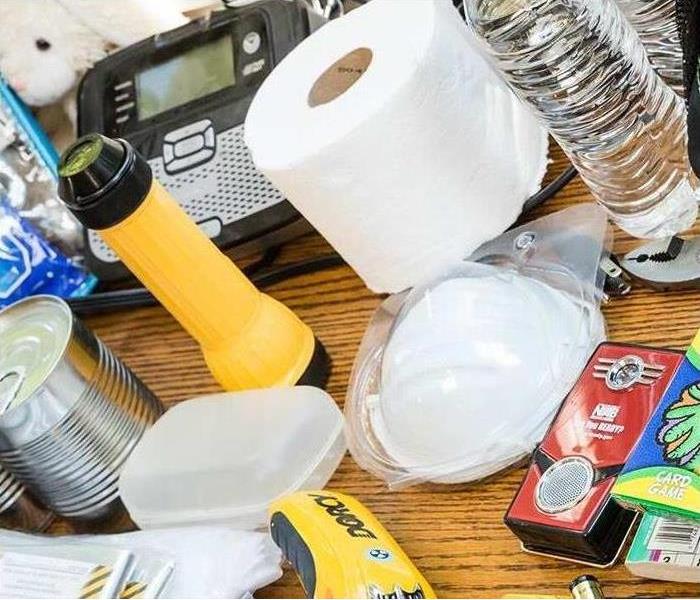Making a Plan/Kit For You & Your Pets for an Emergency
6/24/2021 (Permalink)
Make a Plan, Be Prepared.
Being prepared for an emergency event is a very responsible task you can do for you, your family, and your pets.
Make a Plan
-Put a plan together by discussing the questions below with your family, friends or household to start your emergency plan.
-How will I receive emergency alerts and warnings?
-What is my shelter plan?
-What is my evacuation route?
-What is my family/household communication plan?
-Do I need to update my emergency preparedness kit?
-Remember, during a disaster what’s good for you is good for your pet, so get them ready today.
If you leave your pets behind, they may be lost, injured or worse. Never leave a pet chained outdoors.
Remember, during a disaster what’s good for you is good for your pet, so get them ready today.
If you leave your pets behind, they may be lost, injured or worse. Never leave a pet chained outdoors. Plan options include:
-Create a buddy system in case you’re not home. Ask a trusted neighbor to check on your animals.
Identify shelters. For public health reasons, many emergency shelters cannot accept pets.
-Find pet friendly hotels along your evacuation route and keep a list in your pet’s emergency kit.
Locate boarding facilities or animal hospitals near your evacuation shelter.
-Consider an out-of-town friend or relative.
-Locate a veterinarian or animal hospital in the area where you may be seeking temporary shelter in case your pet needs medical care. Add the contact information to your emergency kit.
-Have your pet microchipped and make sure that you not only keep your address and phone number up-to-date, but that you also include contact info for an emergency contact outside of your immediate area.
-Call your local emergency management office, animal shelter or animal control office to get advice and information.
-If you are unable to return to your home right away, you may need to board your pet. Find out where pet boarding facilities are located.
-Most boarding kennels, veterinarians and animal shelters will need your pet's medical records to make sure all vaccinations are current.
-If you have no alternative but to leave your pet at home, there are some precautions you must take, but remember that leaving your pet at home alone can place your animal in great danger.
BUILDING A KIT:
To assemble your kit store items in airtight plastic bags and put your entire disaster supplies kit in one or two easy-to-carry containers such as plastic bins or a duffel bag.
A basic emergency supply kit could include the following recommended items:
-Water (one gallon per person per day for at least three days, for drinking and sanitation)
-Food (at least a three-day supply of non-perishable food)
-Battery-powered or hand crank radio and a NOAA Weather Radio with tone alert
-Flashlight
-First aid kit
-Extra batteries
-Whistle (to signal for help)
-Dust mask (to help filter contaminated air)
-Plastic sheeting and duct tape (to shelter in place)
-Moist towelettes, garbage bags and plastic ties (for personal sanitation)
-Wrench or pliers (to turn off utilities)
-Manual can opener (for food)
-Local maps
-Cell phone with chargers and a backup battery
Include basic survival items and items to keep your pet happy and comfortable. Start with this list to find out exactly what items your pet needs to be Ready.
Your pet kit should include:
-Food (at least a three day supply in an airtight, waterproof container)
-Water (at least three days of water specifically for your pets)
-Medicines
-Medical records, proof of vaccinations, registration and adoption documents (talk to your veterinarian about microchipping)
-First aid kit (cotton bandage rolls, bandage tape and scissors, antibiotic ointment, flea and tick prevention, latex gloves, isopropyl alcohol, saline solution and a pet first aid reference book)
-Collar or harness with ID tag, rabies tag and a leash
-Crate or pet carrier (a sturdy, safe crate or carrier large enough for your pet to stand, turn around and lie down)
-Sanitation needs (litter box and litter, newspapers, paper towels, plastic trash bags and household chlorine bleach)
-A picture of you and your pet together to prove ownership (add species, breed, age, sex, color and distinguishing characteristics)
-Familiar items (treats, toys and bedding can help reduce stress for your pet)
Being safe and prepared is not only a good idea, but a safe one.
*Source: ready.gov





 24/7 Emergency Service
24/7 Emergency Service
